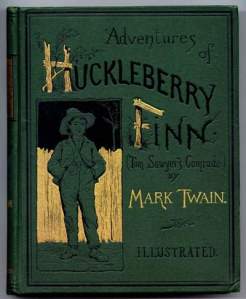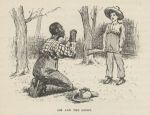Daily Madness #42: One Flew Over the Cuckoo’s Nest :Desktop Wallpaper Design

To download:
* Click on the image to open it in new window.
* Right Click and Save.
Free for personal use.
Fan art inspired by Ken Kesey’s novel, One Flew Over the Cuckoo’s Nest.
Vintery, mintery, cutery, corn,
Apple seed and apple thorn,
Wire, briar, limber lock
Three geese in a flock
One flew East
One flew West
And one flew over the cuckoo’s nest.
~American children’s folk rhyme (Source: Wikipedia)
India Art Summit – Review
Anushka Rajendran, a Delhi-based art writer, reviews India Art Summit 2011:
I must admit up front. Most of my four days at the India Art Summit was spent crouching over a limited edition work by Prajjwal Chowdhury and not so by choice though even otherwise, I would not have minded lavishing quite some time over the work. When I finally got the opportunity to go around, it was just before everything was closing and a half hour there made sure I was way too saturated to witness the rest with any cognitive prowess whatsoever. Still a few works did grab at my interest and they along with the work by Prajjwal Chowdhury make up the premise of this article. What I enjoyed about the summit beyond all else was how by making an event out of artworks that in most cases remained accessible to all and sundry on an everyday basis, putting all of them in the same space, and lavishing the PR industry’s skills on them, could put a whole city in touch with a part of the aesthetic sphere that do not feature very heavily in their quotidian cultural experience. As we all know, it is no well kept secret that the industry enjoys this exclusivity and does not try too hard to change things while keeping an eye out for prospective patrons. I do not want to tread any Marxist discourse here, but these three days when the doors are thrown open to the public, giving them a reason to access the art world, is one of the reasons that makes the summit significant to me.
During the course of my vigil, I had several brief interactions with visitors at the summit. Save the VIP launch, where almost everyone seemed to know what they were talking about or at least what they wanted from the summit, the rest of them predominantly fell under a singular adjective – overwhelmed. I suppose that is what art does to people. Or, maybe I am being overly presumptuous. Back when Clement Greenberg was the last word in art criticism, he was taken very seriously when he laid out an underlying difference between the works of T.S. Elliot and a Tin Pan Alley song, the former being ‘high brow’ where as the latter was ‘popular,’ though both were the offshoots of the same collective society. We no longer adhere to the gospel of Greenberg. Postmodernism came and knocked out cold humorless formalist masturbations (not that I discredit these in any way for most of my favorite artists fit this description).
Though the stalls that welcomed you to the summit mostly featured modern and contemporary masters whose works have become mostly self-referential of their value and genius over anything else it might speak of, weary to the initiated and alien to the uninitiated, the note gradually shifted as one moved along the narrow corridors. Past the Souzas, the Picassos and the Miros, a couple of rungs down but nowhere near down, I came face to face with a work by Mithu Sen that reminded me of the Prajjwal Chowdhury I had been staring at. What I saw was a pink velvet spongy spine, flexible in all its gigantism, going up a wall not unlike a common garden creeper. Her idiom popularly references the kitsch and middle-class household decorative, and takes it very seriously. While she tries to incorporate such a ubiquitous aesthetic into the high space that art assumes, the incongruity of its mere presence on a red carpet playfully pokes fun at taste that may not appear very refined to many connoisseurs. Yet she remains important for this very reason. At the summit, this simultaneously played a different role. For most, right after lines and paint that spoke a language they could not comprehend, for I believe art is an acquired taste, this spine literalized as installation the adjective few of us have not heard – spineless or weak-spined. This is a saying that proliferates, vernacular languages not excluded. This spine brought with it a flash of recognition. Finally something familiar, very relatable.
Similar was the Nano fenced outdoors, decked and decorated with mosaic by Ketna Patel to several times its price, poking fun at Indian Roads and Indian traffic. Prajjwal Chowdhury’s matchboxes carrying images of iconic works that are universally familiar thanks to their heavy dissemination in the mechanical age almost amused whoever chanced by. The use of the matchbox put them in their comfort zone and the recognizability of the images that bring with them some of the fetishized aura of the original, made it endearing. A lot of them wanted to carry individual boxes back with them, not quite able to recognize its status as a work of art. But I must admit, this made me happy. It is not just enough that high and popular art conflate in theory and in practice, as long as the work itself circulates in a highly insulated circuit. The India Art Summit heralds a day when spaces of art conflate beyond mere instances of public art. I have been unfair to some brilliant and note-worthy galleries and artworks in this account by virtue of their omission, most specifically a few that caught my eye like the gallery from Pakistan Grey Noise, Nielson Gallery from Spain and Nature Morte’s booth for Thukral and Tagra’s ‘Put it On’ – whose virtues verge on those of the Mithu Sen as a trophy carried over from their background in advertising. Yet, I hope to have been faithful to the spirit of the summit.
Contact the writer on e-mail: anushka.rjndrn@gmail.com
OR
WikiLeaks’ Julian Assange turns muse for Artists
Since the dawn of mankind, art – to a great extent – has been influenced by the external world. At some level artistic expression can be defined as the result of the mingling or rather clashing of the internal with the external. Events across the world and international politics are therefore muses for several artists. Street art and graffiti probably illustrate this phenomenon the best. In the recent past, an unusual muse has emerged for artists across the globe – Julian Assange.
From a coloring book to full-fledged tribute art – the art world seems to be at the awe of the silver haired Australian. The founder of the whistleblower website WikiLeaks is easily one of the most spoken about and debated about personality in the world. Assange’s efforts to bring out the secrets that the authorities want to push under the rug have shaken the world order. A hero to many, villain to few – artistic tributes to the controversial man is now popping up in every street corner, as well as on the world of internet.
Dubbing Assange the “new folk hero”, a post on Brooklyn Street Art observed,”Pre-dating the modern ‘Street Art’ movement, the street has traditionally been an outlet for the voice of the people and social movements have almost always gained purchase there.
“Posters of underground heroes are as old as ‘Wanted: Billy the Kid’ nail-ups that people used to rip down and take home. The amount of politically motivated Street Art you see or even themes surrounding social issues seem to ebb and flow in quantity, but they are ever present. Villain to some and emerging folk hero to others, Julian Assange, the founder of Wikileaks, has already inspired a comic book in addition to some pieces on the street.”
At the fun end of the spectrum, a website simply called Julian Assange Colouring Book allows users to enjoy the relaxing benefits of “Coloring in” ready made outlines of the gifted computer hacker/journalist/founder and editor-in-chief of WikiLeaks.
“‘Collateral murder’, ‘Cablegate’, sexual misconduct charges against Julian in Sweden, calls for his assassination by the CIA, intrigue, suspense, and conspiracy theories – it all makes for pretty serious stuff.
“So where does the Julian Assange Coloring Book fit in? Well, simply put, it’s not “serious stuff”. It’s a coloring book about Julian Assange (with the occasional WikiLeaks page for good measure),” reads the website’s about section.
But the frivolity – so to speak – ends there as the versatility of the tribute art dedicated to Assange does not fail to awe. A point that needs to be stressed here is the fact that the pieces of reverence towards Assange come from all corners of the world. Amorfart, Hungarian street art site, showcased the making of a five layer stencil on a vinyl album, while the street art from Melbourne has been displayed for the world to see on the photo-sharing website Flickr by Regan Tamanui.
But the best of the lot comes from a French artist called Thierry Ehrmann. Ehrmann is quite a controversial figure. The artist born in Lyon is the founder and current chairman of the Serveur Group, a company that manages databases of art auction quotations through ArtPrice website. Ehrmann sparked off a row in connection with the decoration of his house, the Abode of Chaos. The house located in the peaceful village stick outs as the artist turned it into a replica war zone. Ehrmann is fighting a legal battle to sustain his house in which lives over 2,500 artworks from different artists.
Ehrmann’s photostream on Flickr contains an impressive collection of Assange-inspired art. The first of the three portraits of Julian Assange at the Abode of Chaos has been painted by an artist called Thomas Foucher. The second one has been posted on the occasion of Assange’s arrest, while the third and the most impressive one by Ehrmann has been posted to celebrate Assange being named the Man of the Year by Le Monde. The third portrait of Assange incorporates the fictitious cult-rebel hero ‘V for Vendetta’. While the right half of the portrait is that of Assange, the Guy Fawkes mask that ‘V’ wears forms the left half. This portrayal is extremely striking due to the parallel drawn between the man who fought against the totalitarian government in the Graphic-Novel series by Alan Moore and the man who is fighting against the tightlipped and seemingly scheming leaders and authoritative bodies in a world – present and real – plagued by many miseries.
Never-seen-before pictures of Bob Marley with Marijuana
High Times, the monthly magazine that advocates the legalization of marijuana, has dished out never-seen-before pictures of Reggae god Bob Marley with the herb on the occasion of the 420th issue.
The New York-based magazine decided to release the unpublished outtakes from the photo shoot that Bob Marley did for the cover of September 1976 issue ahead of the release of the book – Bob Marley and the Golden Age of Reggae (Titan Books). The book documents “the golden age of reggae.”
In 1975 and 1976, underground photojournalist Kim Gottlieb and her husband, Island Records publicity head Jeff Walker toured Jamaica and held exclusive meetings in Los Angeles with reggae luminaries such as Peter Tosh, Bunny Wailer, Toots Hibbert, Burning Spear, Jacob Miller, Third World, and Lee ‘Scratch’ Perry, besides Bob Marley.
High Times has released five unpublished photos of Bob Marley with marijuana. In one the artist is examining the “photo props” at the shoot. In two other photos Bob Marley is accompanied by Bob and Wailers percussionist Seeco Patterson. While in the fourth Bob is seen standing as he “chops up herb for another spliff”, the fifth one shows “Bob in contemplation”.
In the piece Jeff Walker recalls, “During some down time between the Roxy and the Santa Barbara County Bowl, Kim and I went to Bob’s hotel to shoot a private session for the now-iconic HighTimes cover that would feature Bob smiling over a mound of herb. His delight that afternoon is pretty evident in these never-before-seen photos of that session.”
“Two days later, as the sun set on Bob Marley as he neared the end of his outdoor concert at the Santa Barbara County Bowl, none of us could have imagined what lay ahead in the next few years – from the attempt on Bob’s life in his home as he was rehearsing for the “Smile Jamaica” concert (meant to help simmer down a very tense political climate in Kingston) to the diagnosis of the cancer that would eventually take his life way too soon. But on that day in Santa Barbara, in an idyllic setting, Bob was at the peak of his powers, and his legend would only continue to grow.”
Bob Marley died on 11 May, 1981.
Sanitizing Huckleberry Finn = Whitewashing History
An attempt to edit, or rather censor, Mark Twain’s The Adventures of Huckleberry Finn, one of the greatest novels ever written, has sparked off a row.
Taking offense to the occurrence of the ‘N-word’ 219 times in the book, Alan Gribbons, an Auburn University Professor, has taken up the responsibility to rid the American classic of those words. The new version of the book, which would be published by NewSouth Books in Feb 2011, will have the word ‘slave’ replace the ‘N-word’.
“It enables us to set this inflammatory racial epithet aside and begin to address the greatness of Twain’s works,” CBS quotes the professor as saying.
Gribbons told USA Today of the troubles teachers are facing due to the contents of the book, which parents and children find “injurious” and “hurtful”.
Justifying his controversial move, the Professor says that he is revising the text to make it more readable and argues that the readers would still get the essence of Twain’s message.
While there is small fraction of the society that seems to be heaving a sigh of relief on the move (ex: few mothers of school children), this attempt to “sivilize” Twain’s book just like how his character Widow Douglas tried to “sivilize” Huck has invited the ire of many. People have spoken out against the “censorship” and the revision of the masterpiece, which is considered a sin among the literary circles.
Several online campaigns have also begun. One among those is on the social networking site Facebook, titled Boycott NewSouth Books.
“The revision and censorship of literary works is wrong and should be stopped. It is wrong to “clean” the works of masters because someone is too lazy to explain to new readers why something was written the way it was. Companies that take this step need to be rebuked in the harshest form. Deny them business,” the description reads.
The campaign has already been been ‘liked’ by 100 users, it is only a matter of time before this number goes up judging from the response to the news on the revision have evoked so far.
Huckleberry Finn has been trending on Twitter for several hours now. Some of the Tweets are listed below:
jess3 wrote: “Snooki wrote a book and Huckleberry Finn is being censored. It’s official: literature is dead. Great way to start the new year!”
StephenAtHome posted: “It’s great that they took the N-word out of ‘Huckleberry Finn’. Now get to work on ‘Moby D-Word’.”
ZacGlitchBuster tweeted: “Huckleberry Finn is being censored. A tragedy. It also shows how spineless some schools are. Pathetic”
Pixies say:
As writers and artists yourselves, we stand against any form of censorship. The move to take out the ‘N-word’ from Huckleberry Finn is a mindless act as the authenticity of the text would be lost in the process.
The book is based in Missouri in the 1830s and 1840s, in a time and place where the epithet was widely used. Mark Twain’s works often elicit reading under realism. The truth and the reality of the settings reflected in the book can not be obscured, to no extent what so ever.
If we can not teach our children of what constitutes the human history and the horrific realities of the centuries past, then why teach them anything at all. Don’t we read history, hoping that when it repeats itself we are equiped with enough rationality to not commit the same mistakes?
Moreover, the replacement of ‘N-word’ with “slave” only re-asserts the institution of slavery.
Besides, Twain’s efforts to capture the reality also included writing to reproduce the dialect. All those who have studied literature have learned how the writer reproduced several dialects, including the “Missouri negro dialect”. While Huck does not speak “proper English”, Jim, the slave of Miss Watson, speaks bad English with a very heavy accent.
So this revision, not only censors, but also deforms the genuineness and genius of the text; while the choice of word substitute is poor as well as pointless.
Omékongo Dibinga, a spoken word artist, rapper, actor, one of Les Brown’s hand selected platinum motivational speakers and a winner of Urban Music Award Winner, says on CNN iReport, “Editing these texts is essentially rewriting them.
“We should not be politically correct about our history. For all of American history’s positivity and negativity, it’s still our history. Let’s not try to whitewash it.”
However, one consolation for those against the revision is the fact that NewSouth is not the only publisher. The original version of the book will still be in circulation as there are several other publishers that publish the classic.














